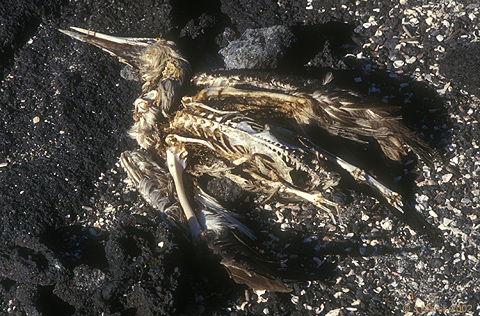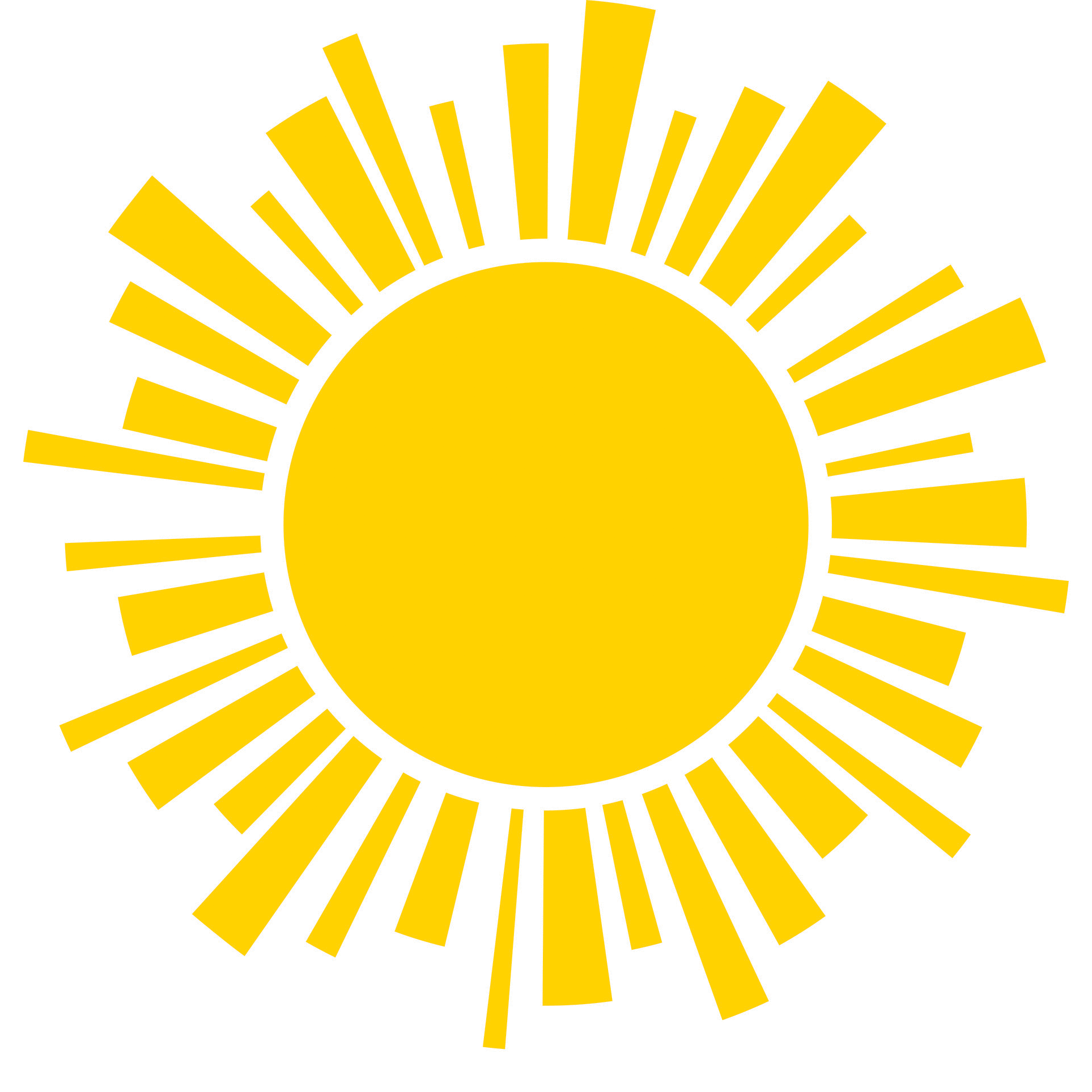- Producers: Organisms that harvest energy from non-biological sources in the environment, For the land community, the producers are green plants.
- Consumers: Organisms that "steal" energy by eating others.
- Primary consumers get their energy from producers,
- secondary consumers eat primary consumers, etc.
- Decomposers: Sort of a special case of consumers, these include organisms like bacteria and fungi that are the ultimate consumers of energy. The result of their work is the reduction of living things to non-living components which may become part of the non-living substrate of the ecosystem, such as soil. Of course, in fact, decomposers may be preyed upon, too, like when you eat a mushroom pizza.
For the purposes of our presentation, the terrestrial commnity consists of land plants and all of the critters that get their energy from them. Thus, for the moment, creatures like sea birds and marine iguanas don't count, even though they often hang out on land. Emphasizing this disconnect is the fact that climatic episodes like El Niño effect the marine and land realms differently.
Jackson organizes the major members of the terrestrial ecosystem into a food web. Below is my embellished version:
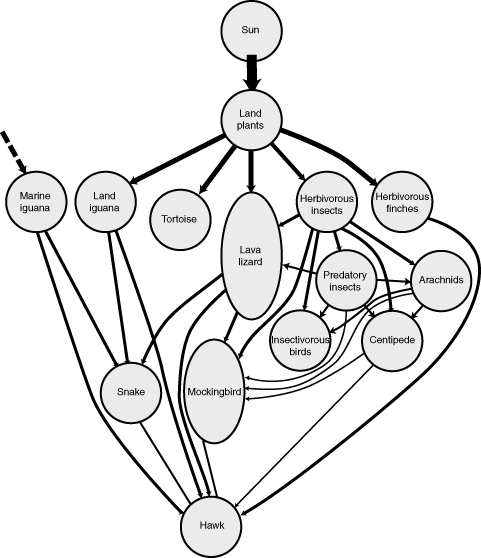
A couple of comments:
- The Galápagos are really atypical in possessing some primary consumers that are, as adults, untouchable by predators - tortoises and land iguanas. These animals, however, can be preyed upon by snakes and/or birds of prey as juveniles.
- Marine iguanas get their food from the ocean and are included here only because their bodies feed a number of land animals. One might similarly include sea birds.
- Although all critters in the web are interconnected, certain ones serve as nexuses connecting many other members. These are often ecological generalists that can act as consumers at different levels. Lava lizards, for example, are both primary consumers (of plants) and secondary consumers (of insects.) Note also insects and mockingbirds.
- Slighty weird: In the Galápagos, a centipede sits rather high on the food chain.
- The ultimate consumers are birds of prey such as the Galápagos hawk, Galápagos owl, and Galápagos barn owl. As a secondary/tertiary consumers, their biomass is substantially less than that of most other critters. (Note: on Genovesa, owls are, essentially, members of the marine community since they prey exclusively on critters whose energy comes from the sea.)
A brief orientation to the more familiar land animals:
Primary consumers
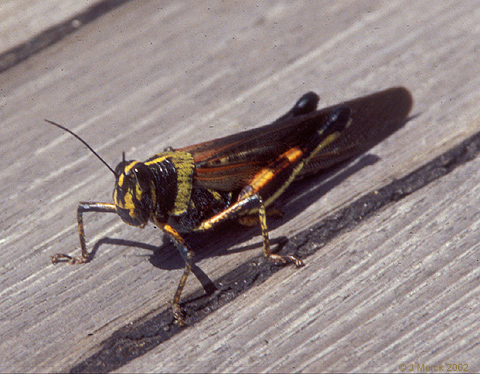 Insects: As anywhere, there is a great diversity, but not so many that a person can't keep track of the important ones. Many of the conspicuous herbivorous insects are nectar-feeding pollinators:
Insects: As anywhere, there is a great diversity, but not so many that a person can't keep track of the important ones. Many of the conspicuous herbivorous insects are nectar-feeding pollinators:
- Carpenter bee: (Endemic) Solitary and sexually dimorphic with indigo-black females and yellow-brown males.
- Lepidoptera: Moths and butterflies - Originally thought to contain seven endemic species, which resemble mainland relatives. More recent surveys have turned up twelve, several of which are poorly studied. You're very likely to see:
- Queen butterfly: (Native) Large, orange, and similar to a monarch.
- Silver fritillary: (Endemic) With white spots on underside of hindwing.
- Large-tailed skipper: (Endemic) Small and dark brown with long "tails".
- Galápagos sulfur: (Endemic) Bright yellow.
- Galápagos blue: (Endemic) Tiny with blue on upper wing surfaces.
- Orthoptera: Grasshoppers and katydids - The Galápagos boast the most beautiful grasshopper in the world, the painted locust (Endemic). These beefy insects are a major food source for lava lizards.
- Others: Various beetles and true bugs. One odd insect of note is a recently introduced exotic, the Cottony cushion scale, which is attacking native plants and appears to have no natural predators.
(Right: Painted locust Schistocera melanocera)
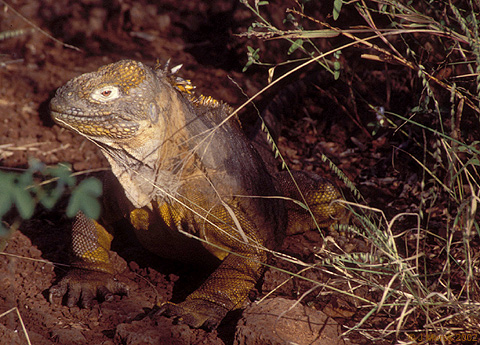 Reptiles: We have two lizards and the tortoise:
Reptiles: We have two lizards and the tortoise:
- Land iguana: (Endemic)
- These large lizards feed mostly on prickly-pear pads and fruit, althought sometimes they might take small prey.
- Sexually dimorphic, with males being larger and prettier. Land iguanas are territorial and highly intolerant of others of their own gender. Males exclude one another from territory containing females, while females protect nesting burrows. This, combined with the fact that they have begun to evolve shyness as a result of hunting by humans and introduced mammals makes them somehwat harder to observe than other Galápagos critters.
- Although they don't love water, they seem to be capable of dispersing across it, because most islands' land iguanas belong to a single species, Conolophus subcristatus. Two local endemics exist:
- The Santa Fe land iguana Conolophus pallidus.
- Conolophus marthae, the rosada or pink land iguana recently (2008) discovered on the heights of Volcan Wolf.
(Right: Galápagos land iguana Conolophus subcristatus)
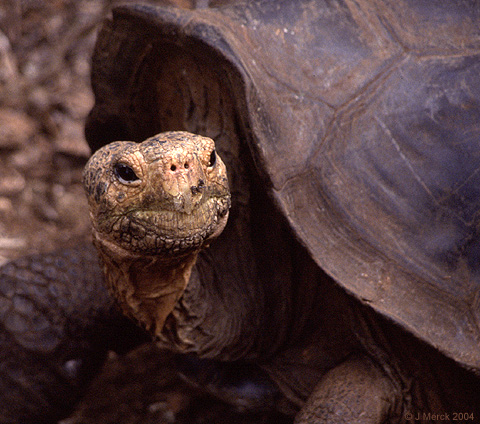
- Galápagos tortoise: (Endemic) Much has been said and written about these creatures. To reiterate some major points:
- Major herbivores, eating a variety of vegetable matter.
- Until recently regarded as belonging to a single species, Geochelone elephantopus, each island having a morphologically distinct "race." The current trend is to regard the island "races" as separate species of Chelonoidis.
- (Domed and Saddleback) Tortoises have historically inhabited all of the large islands except Fernandina.
- On Isabela and Santa Cruz, the tortoises trek between watering holes in the uplands and feeding grounds in the arid zone.
- These creatures reproduce slowly and have been severely reduced by hunting in historic time. Tourists are not taken into their habitats in the park, so we probably will not see a wild one. We will visit the captive propagation facitity at the Darwin Research Center.
Note: The tortoises are famous for their 200 year+ life span. Land iguanas are no slouches, either. Their true life span is unknown but appears to exceed 60 years. This brings up an interesting evolutionary note. Creatures that are unlikely to die of accident or predation have an opportunity that is denied to most creatures: The chance to for natural selection to select for variants that are better at maintaining and repairing their bodies at later life stages. Possums and armadillos don't get that chance because they are typically converted to road-kill long before they can manifest any such variation from which to select. (Right: Galápagos tortoise (Española morph) Chelonoidis nigra hoodensis)
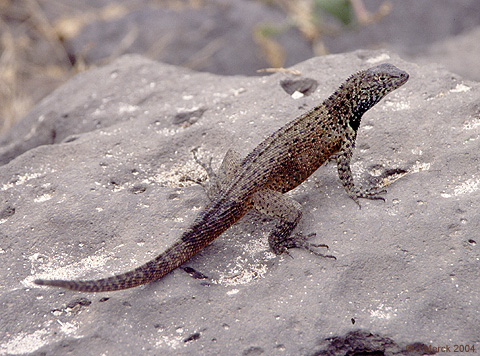
- Lava lizards: (Endemic) More interesting than they look. These creatures are a keystone in the Galápagos food web:
- They are ubiquitous on all islands except Genovesa.
- Omnivores, eating vegetation and insects, and a major food source for other predators.
- Sexually dimorphic. Typically, females have an extensive "feminine" blush of red or orange beneath their neck. Males have manly pattern.
- At least three species are present. One each for Española and San Cristóbal, and one for the central and western islands, but even there, there is inter-island variability.
- Recent taxonomic revision had changed their genus name from Tropidurus (used by Jackson) to Microlophus.
- A personal observation. Because their generation time is shorter, it stands to reason that evolved behavioral reactions to humans might be observed in these little guys. Sho 'nuf, when we were on Baltra (host to a military base since 1941) we noticed that there and there alone, the lava lizards were somewhat skittish.
Birds: The seed eating and folivorous members of Darwin's finches play the primary consumer part. Without belaboring the issue, the finches we will most often encounter are:
- Ground finches: (Endemic) Come in large, medium and small varieties, although all three generally don't occur on the same island. Espect to see plenty of medium ground finch.
- Dedicated seed eaters seeking to strike a balance between the ability to deliver a powerful bite, and the ability to get by on very little food. Peter and Rosemary Grant have studied the finches of Daphne Major since the 1970s. In the late 70s, they witnessed a year with no rainy season. This produced the strongest episode of directed natural selection every recorded, with beak height among large ground finches increasing by 10%. (A few finches with the smallest beaks survived because the birds, being smaller, required less food.)
- Sexually dimorphic, with males being dark brown/black while females are light brown with streaked chests.
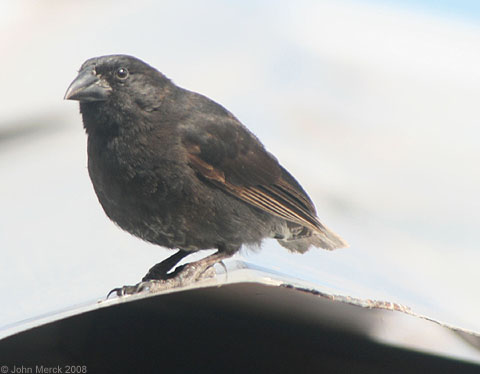
- Cactus finches: (Endemic) Come in large and common sizes. Have beaks that are narrower and more pointed than ground finches. These creatures eat, take shelter, and nest in Opuntia.
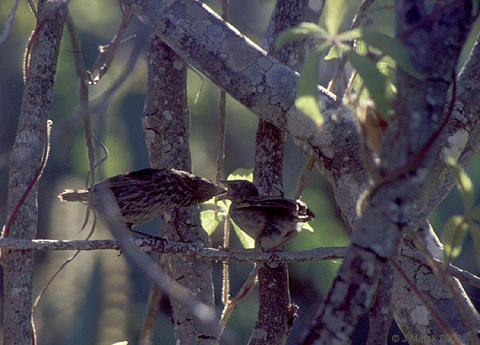
- Tree finches: (Endemic) Omnivores. Like ground finches, come in small, medium, and large sizes:

- Galápagos dove: (Endemic) Not a finch, but another endemic seed/plant eater. Compare with the North American morning dove.
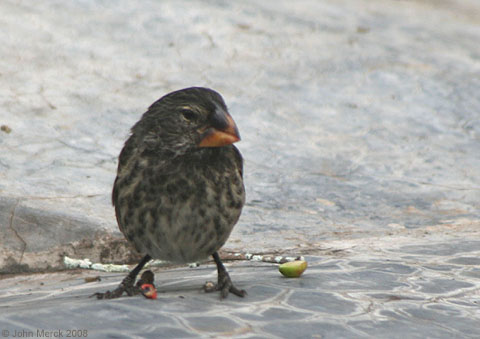
Secondary consumers
Insects: Yeah, predatory insects. A couple worth noting:
- The South American saddlebags, Tramea cophysa: (Native) A conspicuous dragonfly. Considering that dragonflies spend their early lives in fresh water, it's amazing that there are abundant dragonflies in the Galápagos. They breed in tide pools where fresh water forms a surface layer. There are said to be eight species of dragonfly or damselfly on the Galápagos but we have so far only seen this one and the great pondhawk, Erythemis vesiculosa. (Right: South American saddlebags, Tramea cophysa. Note: This insect is erroneously identified in Fitter et al. field guide as Pantala hymenaea - Spot-wing glider.)
- Polistes versicolor: (Exotic) Near black mangrove trees, you will be aware of this recently introduced hornet. These are linked to a decline in the mangrove finch, an insect eater. Apparantly the hornet is better at hunting insects in the mangrove environment and is slowly excluding the finch.
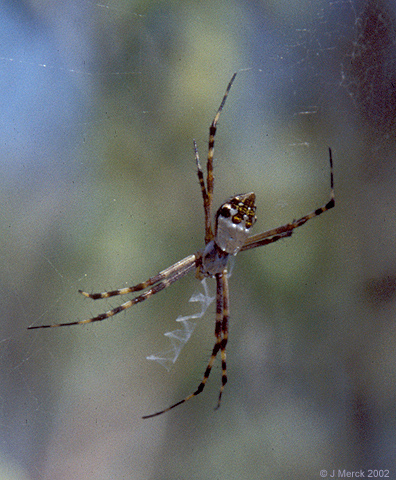 Other arthropods:
Other arthropods:
- Scorpions: There are two species. Centruroides exsul. Be warned.
- Spiders: Several conspicuous endemic varieties. One to look forward to is the beautiful Argiope argentata (right).
- Centipede: (Endemic) The Galápagos centipede, Scolopendra galapagensis is interesting in that it occupies a position in the Galápagos food web analogous to that of a small mammalian predator on the mainland. Indeed, the Galápagos are odd in that the near absence of native mammals has enabled unlikely critters to step into their place.
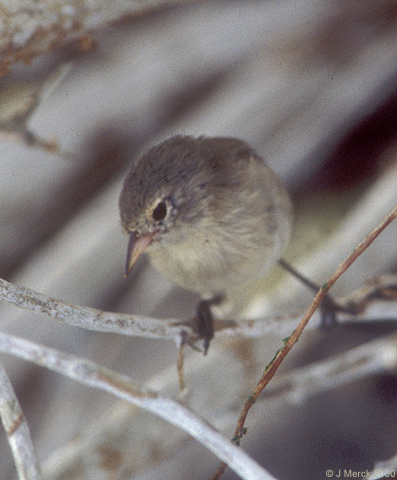 Insectivorous birds: This encompasses a wide range of endemic, native, and exotic species. Of particular note:
Insectivorous birds: This encompasses a wide range of endemic, native, and exotic species. Of particular note:
- Warbler finch: (Endemic) Darwin's warbler-look alike finch has a short narrow beak, and hunts insects in foliage.
- Galápagos flycatcher: (Endemic) One of two tyrant flycatchers.
- Vermilion flycatcher: (Native) The other. Males are bold red and black. Unlike their cousins in North America, they display the characteristic Galápagos approachability.
- Yellow warbler: (Native) A real warbler, native both to the islands and the mainland. In North America, you count yourself lucky to see these, but in the Galápagos they are as common as starlings and display the typical local naivete.
- Groove-billed ani: (Exotic) A cuckoo recently introduced from the mainland (perhaps deliberately by ranchers). These have been in the islands perhaps less than 20 years, and behave like typical fearful mainland birds.
(Right: Warbler finch Certhidia olivacea)
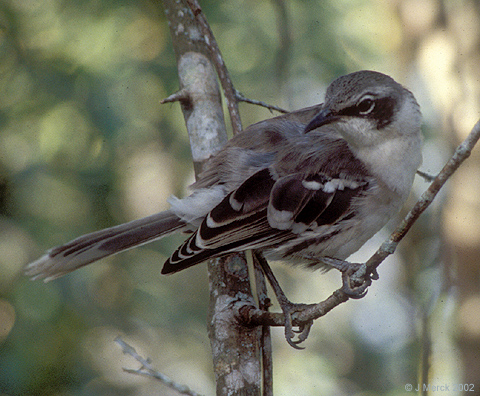
Higher-order consumers
Mockingbirds: When Darwin visited the islands, these were the birds whose island-to-island variation most struck him. Like the local northern mockingbird, these creatures are surprisingly bright ecological generalists. They are also capable of hunting young lava lizards, centipedes, and nestling land birds, as well as insects. They are likely to investigate us and, if they are desparate, beg for food or water from us. Their species distribution mirrors that of the lava lizards, with one species each for the old islands, Española and San Cristóbal, and one for the central and western isles:
(Right: Galápagos mockingbird Nesomimus parvulus)
- Scorpions: There are two species. Centruroides exsul. Be warned.
- Galápagos snakes: There are three very similar species in two genera. Alsophis slevini and Alsophis dorsalis are spread throughout the central and wester isles while the older islands of Española, San Cristóbal, and Floreana are inhabited by Philodryas biserialis. All species are brown with dull yellow stripes, feed on small reptiles, and are mildly venomous. Like the finches, these snakes are next to impossible to identify in the field.
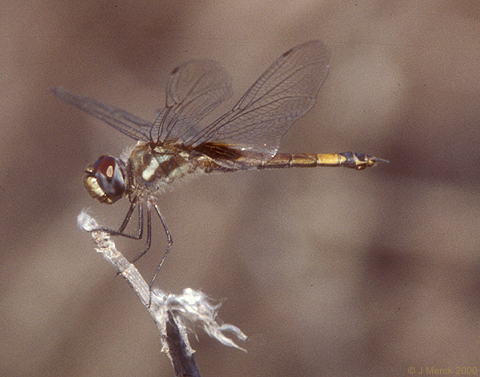
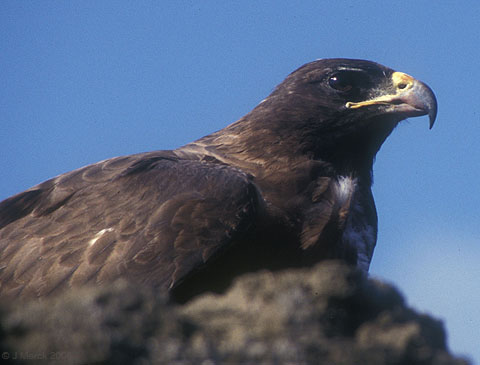 Top of the food chain: The ultimate consumers are birds of prey, foremost, the hawk
Top of the food chain: The ultimate consumers are birds of prey, foremost, the hawk
- Galápagos hawk: Like other buteos (broadwinged hawks) of the Americas, this hawk hunts by perching on a high branch or rock and watching for movement. The hawk consumes juvenile iguanas, lava lizards, and other non-flyig animals small enough to swallow whole. It is closely related to Swainson's hawk of North America.
- Galápagos short-eared owl: A short-eared owl that has become a diurnal predator. When available, this owl eats non-flying prey like the hawk, but on Genovesa, where lava lizards are absent, it stalks storm petrels and other small sea birds. On islands like Santa Cruz, where the hawk is also present, the owl is more active during evenings - niche partitioning!
Galápagos barn owl: Slightly smaller than the American barn owl, this invisible creature eats small mammals and insects.
(Right: Galápagos hawk Buteo galapagoensis)
Of course, the terrestrial energy web is not totally isolated from the marine web:
- Packages of marine energy in the form of dead marine iguanas and sea birds make their way into the terrestrial network.
- Nutrients from the decomposition of terrestrial organisms get washed into the oceans.
